At-a-glance: Art's most powerful people
- Published
ArtReview magazine has named its 100 most powerful people in the art world for 2011.
The list ranges from internationally renowned figures like Ai WeiWei and Cindy Sherman, to private collectors such as Patricia Phelps de Cisneros.
Below are brief biographies of the top 10.
1. Ai Weiwei (China)
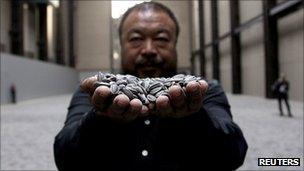
Ai Weiwei created the sunflower seed installation at Tate's Turbine Hall
Best known for ambitious, large-scale projects such as the Bird's Nest stadium he designed for the Beijing Olympics, Ai Weiwei is one of China's leading contemporary artists.
He is the son of one of China's most famous poets, Ai Qing, and studied at Beijing's Film Academy before becoming a founder member of an avant garde art group called The Stars.
Working across multiple disciplines, he has created installations, photographs, furniture, paintings, books, and films during his four-decade career.
But he is equally well-known for his criticism of the Chinese authorities.
His widely-read blog was shut down when he published the names of 5,835 students killed in the 2008 Sichuan earthquake.
A year later, when Denmark loaned Edvard Eriksen's famous Little Mermaid statue to China, Ai was asked to create a replacement.
Instead, he installed a television feed of the statue in its temporary home in Shanghai, saying: "That's our real life. Everybody is under some kind of surveillance camera."
Earlier this year, the 54-year-old spent 81 days in prison, ostensibly for "economic crimes", although many observers said the sentence was related to his outspoken politics.
2. Hans Ulrich Obrist (Switzerland) and Julia Peyton-Jones (UK)
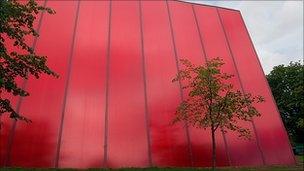
The Serpentine Gallery Pavilion 2010 by Jean Nouvel
The creative forces behind London's Serpentine Gallery, ArtReview calls this power couple a "curatorial dynamo".
Obrist first came to the gallery as a guest curator in 1995, mounting a free-wheeling exhibition called Take Me I'm Yours, in which Gilbert And George gave away badges and Christian Boltanski allowed people to fill plastic bags full of second-hand clothes for a pound.
Since taking up a full-time role in 2006, he has worked hand-in-hand with Peyton-Jones to make the Serpentine a centre for the discussion and propagation of contemporary art.
Aside from exhibitions, it stages talks, residencies and "marathons" - ambitious two-day events that bring together artists, poets, philosophers, scholars, musicians, architects and scientists to explore a theme (gardens, maps, interviews) in a non-stop programme of live events.
Peyton-Jones, who has been director of the Serpentine since 1991, was also responsible for establishing the Serpentine Gallery Pavilion, which showcases large-scale architectural works by the likes of Frank Gehry, Oscar Niemeyer and Daniel Libeskind.
3. Glenn D Lowry (US)
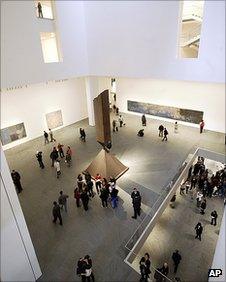
The cavernous interior of MoMA is instantly recognisable
Lowry has been director of New York's Museum of Modern Art since 1995.
He leads a staff of 750 and directs an active program of exhibitions, acquisitions, and publications.
Under his tenure, the museum has acquired major works by Henri Matisse, Andy Warhol, Gerhard Richter and Louise Bourgeois; and presented major exhibitions such as Georges Seurat: The Drawings, Richard Serra Sculpture: Forty Years and Matisse Picasso.
Over the last 12 months, he has been praised for expanding the institution's collection and securing new premises - taking over the American Folk Art Museum, two doors down from MoMA in central New York.
Current exhibitions include the first major museum retrospective of Dutch abstract artist Willem de Kooning, which inhabits the entire sixth floor of the building.
Critics point out he has raised admission prices from $20 (£12.70) to $25 (£15.90) this year, but the museum remains confident that visitors will accept the rise, after holding the previous price for seven years.
4. Larry Gagosian (US)
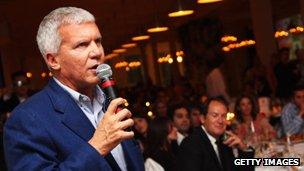
Gagosian has been called "the world's greatest art businessman"
Art dealer Larry Gagosian has fallen from the top spot on last year's Art 100 list - but that doesn't mean he has been resting on his laurels.
Over the last year, he has staged an exhausting 58 shows in 11 galleries, including exhibitions by Richard Prince, Takashi Murakami, Richard Serra and Bob Dylan.
Picasso: The Mediterranean Years, shown at his London gallery last summer, was curated by the artist's grandson, Bernard Ruiz-Picasso, and praised for turning the spotlight on his domestic life.
Famously wary of the media, the Armenian-born Gagosian rarely gives interviews - which merely adds to his mystique.
He claims to have started his career selling $15 framed posters on the street in Los Angeles, and had opened a gallery Chelsea, New York within 10 years.
These days, his galleries make an estimated $1 billion (£637m) in sales every year, Gagosian travelling between them in style on his private jet.
His roster includes headline-grabbing artists like Damien Hirst, Jeff Koons and Cindy Sherman, but he is known for "poaching" clients from other dealers once they have achieved popularity.
ArtReview says his most ambitious show, external of the last 12 months was Malevich and the American Legacy, held at his Madison Avenue gallery.
Spanning 60 years, it featured works by Barnett Newman, Cy Twombly, Agnes Martin and Dan Flavin - prompting the magazine to say it "came close to constituting a history of postwar American art".
5. Anton Vidokle (Russia), Julieta Aranda (Mexico) and Brian Kuan Wood (US)
Vidokle, Aranda and Wood established the e-flux newsletter, distributed to more than 50,000 readers worldwide by email every day.
It is used by the likes of The Guggenheim, the Tate Modern, the Venice Biennale and Art Basel to discuss and promote their work.
The service was born in 1998 when Vidolke organised a one-night exhibition in a Holiday Inn in New York's Chinatown district. With no money to publicise it, he sent out invitations on his newly-opened email account.
To his surprise, hundreds of guests showed up - sowing the seeds of the idea for the newsletter, which launched a few months later.
The organisation has since expanded, staging events and projects around the world, and publishing a regular journal with essays by the likes of Boris Groys and Diedrich Diederichsen.
6. Sir Nicholas Serota (UK)
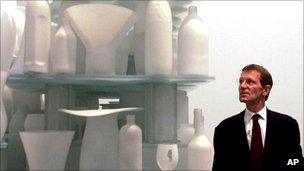
Sir Nicholas Serota oversees the Tate's four galleries
Director of the Tate since 1988, Sir Nicholas has oversight of four galleries - Tate Modern, Tate Britain, Tate Liverpool and Tate St Ives.
Despite a 15% cut in its government grant, the UK's biggest art institution has seen a record 7.4 million visitors and an increase in its commercial income over the last 12 months.
Blockbuster shows this year included a retrospective of Belgian Surrealist Rene Magritte, a critical reappraisal of French post-impressionist Gaugin and Ai Weiwei's troubled Turbine Hall installation of porcelain sunflower seeds - which were found to be coated in lead paint.
Trained at Cambridge and the Courtauld Institute of Art, Sir Nicholas was previously director of the Museum of Modern Art, Oxford and the Whitechapel Art Gallery.
A widely-revered figure in the art world, he also commands the respect of his employees.
"Whenever the people who work with me get downhearted," he told Vogue magazine, external, "I remind them of how incredibly fortunate they are.
"They've had the chance to help create London's first museum of modern art - and how often do opportunities like that come along?"
7. Cindy Sherman (US)
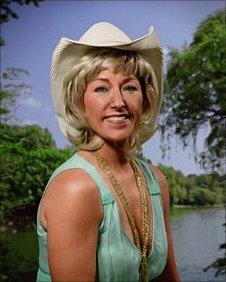
Andy Warhol once said of Sherman: "She's good enough to be a real actress"
Arguably the most famous living art photographer, Sherman has made a career of turning the camera on herself.
She is adamant that her photos are not self-portraits, though, as Sherman raids the dressing-up box to create characters and narratives that question the position of women in modern society.
Born in 1954, in New Jersey, she claims to have failed her first photography class because she couldn't work out how the camera worked.
She persevered and eventually passed the class, bursting on to the art scene in the early 1980s with her series Untitled Film Stills, where she played vamps, b-movie stars, housewives and pin-ups.
One of her early photographs sold in May for $3.89m (£2.47m), becoming the most expensive photograph ever sold at auction - and she has been cited as an influence by the likes of Lady Gaga.
Outside of the art world, she trains as a boxer with Carlos Ferrer, the former personal coach to Naomi Campbell.
8. Iwan Wirth (Switzerland)
Described by the Telegraph, external as "one of the most powerful modern art dealers in the world," Wirth was born in the small Alpine town of St Gallen.
He says he first felt the thrill of trading art for money at the age of seven, when he and a cousin created miniature versions of Henry Moore sculptures and sold them out of his grandfather's workshop.
They made about 75 francs each. These days, Wirth handles sums ending in many, many more zeroes.
He has galleries in Zurich, New York and London, and he has worked with the likes of Turner Prize winner Martin Creed and sculptors Ron Mueck and Paul McCarthy.
2011 marked his 20th year in the business, alongside his wife and business partner Manuela Hauser.
To celebrate, they opened a new gallery in London's Mayfair and staged an ambitious, multi-storey installation, external, designed to look like a community drop-in centre, by Swiss artist Christoph Bruchel.
9. David Zwirner (Germany)
Gallery owner Zwirner has followed in the footsteps of his father, Rudolph, himself an art dealer.
He opened his first gallery in SoHo, New York, when he was 27 and quickly gathered a roster of up-and-coming artists around him.
Zwirner's current stable includes the likes of German photographer Thomas Ruff, provocative pulp artist Raymond Pettibon, and conceptual videographer Stan Douglas.
His gallery, which moved to Chelsea in 2002, features a range of art from minimalist works to large-scale installation and time-based performances and video work.
Zwirner's place on the ArtReview list comes after he set up a charity auction to help the victims of the Haiti earthquake.
After travelling to the country with actor Ben Stiller last year, Zwirner organised a sale of art at Christie's in New York, at which 100% of the profits went directly to relief efforts.
The event raised $13.7 million (£8.7 million), with the gallery owner himself contributing $300,000 (£191,000) to pick up Francis Alys's Le Juif Errant.
10. Beatrix Ruf (Germany)
Ruf is the director of contemporary art centre Kunsthalle Zurich, where she has been stationed for 10 years.
Over the course of her career, she has organised exhibitions, written essays and published catalogues on artists as diverse as Monica Bonvicini, Peter Doig and Marina Abramovic.
She has been called "the anointer" - if she takes a new talent seriously, the rest of the art world sits up and pays attention.
Her opinions and expertise are sought internationally - acting as a judge for the Prix Lafayette and LUMA prizes.
In her capacity as artistic director of the Ringier Collection, she has spent the past six years enabling a full inventory of work by the late American artist Mark Morrisroe to be assembled and stored at the Fotomuseum Winterthur.
Ruf was recently appointed to the newly constituted cultural advisory board of CERN, which operates Europe's Large Hadron Collider.
- Published13 October 2011